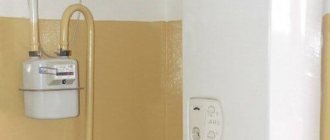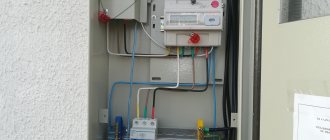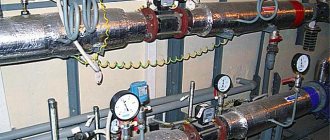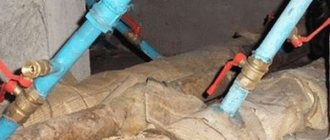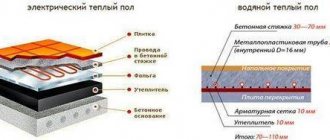Heating is one of the most important communications in an apartment. This system is necessary for heating the home during the cold season.
Previously, apartments were heated using a central heating system (CHS). But today many are switching to “autonomy”.
Read more about how to make individual heating in an apartment building further in the article.
Why do residents refuse central heating?
There are a number of reasons for this:
- unjustified heating costs;
- poor-quality heating of the apartment during the cold period;
- improper heat distribution (especially for corner apartments and rooms located on the ground floor);
- dependence on the established timing of the heating season (cold in autumn and hot in spring);
- inability to maintain the desired temperature at any time.
Judging by the reviews, those who abandoned the central heating system and spent money on installing a “autonomous system” quickly return the invested funds, saving on utility bills.
Pros and cons of individual heating
The advantages of autonomous heating are obvious:
- Significant savings. According to reviews from residents who have switched to “autonomy”, heating costs are reduced by 5–7 times.
- Ability to regulate the air temperature in the apartment. Some heating systems allow you to set the required mode, in which the intensity of heating the room changes at programmed intervals. For example, in the first half of the day, when all family members are at work or school, the temperature drops, and in the evening it rises again. This mode also leads to cost savings.
- Hot water supply.
- Possibility of choosing radiators. Any batteries are suitable for an autonomous system, since in this case there is no possibility of water hammer.
The disadvantages of an individual heating system are as follows:
- High cost of equipment and system elements.
- Dependence of the latest boiler models on power supply.
- The need to install a new heating circuit.
- In many cases, it is necessary to install a suitable exhaust duct.
Installation process
Installation work to install the heating system is carried out in accordance with technological requirements and is carried out in several stages. Failure to comply with clear rules and requirements can cause incorrect operation of the equipment and lead to an emergency.
Marking
First of all, markings are applied in places where pipes will pass and radiators will be installed.
In order for the elements of the highway to be at the same level, as required by the technology, marks are placed using a level.
Radiator installation
At the next stage, the batteries are attached to their seats. To do this, holes for fasteners are drilled at the marked points with a hammer drill, which need to be secured with dowels.
Radiators are hung on the installed fasteners, and fittings are screwed to them.
Pipe laying
Then they begin to pull the pipes. Their assembly begins from the beginning of the wiring and, accordingly, the return. Using a soldering iron, fittings are welded to the edges of the pipes that will connect the line to the heating boiler. The soldering process consists of stripping the edges of the pipes from foil and inserting them into the nozzle of a heated soldering iron; in parallel, the fitting is heated in the same way to the desired temperature (usually 260 °C).
Next, the parts are joined with hot edges in a straight line and pressed tightly - this forms a homogeneous permanent connection. Similarly, the edges of the contour parts are connected along the entire perimeter of the apartment. To avoid deformation of the pipes, they are fixed to the wall with fasteners every 65–70 cm.
At the junction of radiators with plastic elements of the heating system, corner valves are welded. The system is ready for connection to a gas boiler, the installation and connection of which is best left to qualified specialists due to the complexity of the work and increased safety measures for its implementation.
How to switch to individual heating?
In order to understand how to switch an apartment to individual heating, you need to know the legal norms.
The installation procedure is regulated by several regulations, namely:
- Federal Law No. 190 “On Heat Supply”;
- Art. 26-27 Housing Code of the Russian Federation;
- Government Decree No. 307.
To transfer an apartment to individual heating in an apartment building you need:
- Submit an application for waiver of the CSO.
- Obtain the consent of various structures for this.
- Submit an application to the district electrical network office for the installation of individual heating in the apartment.
To install autonomous heating in an apartment, it is necessary to obtain the consent of local authorities, residents of the entire building, gas workers, and architects.
Is there a benefit?
Equipment for autonomous heating in your apartment costs a lot, and how many bureaucratic barriers will you have to overcome...Is the game worth the candle? It's time to talk about the benefits that autonomous heating in your apartment will give you.
- Saving. You will no longer have to pay for many things that do not belong to your apartment. And this includes the maintenance of heating mains, energy losses during transmission from thermal power plants, and the operation of boiler houses, and much, much more.
- You can regulate the temperature in the apartment by increasing or decreasing the gas supply or current in the boiler. And you will forget about how, when the central heating is turned on for the first time, the utility workers heat it so that the pipes become hot. And in severe frosts, even at elevated temperatures, many apartments do not warm up enough, and the rooms are cool, especially on the top floors. Moreover, you can regulate not only the power of the boiler, but also the power of modern radiators. This means that the rooms can be set to a truly comfortable temperature.
- The next plus is partial autonomy. Who has not encountered the “whims” of central heating, which are associated not only with utility accidents, but also simply with routine pipe repairs. There remains, of course, some danger of power and gas being cut off, but if this happens in the city, it will not be for a long time. It goes without saying that in winter, cutting off gas or electricity even for an hour can lead to serious cooling of the room, and therefore it is advisable to stock up on a backup battery, as well as insulate the walls to reduce heat loss. If you have centralized heating, then it is almost impossible to regulate the heat supply.
However, we must not forget that the power of the boiler in the apartment can be adjusted within certain limits. There are standards that cannot be violated. So, if you reduce the power of the heating device too much, this can lead to the fact that neighboring apartments will become too cold.
What must be observed during the transition?
The legislation imposes the following requirements for the premises where autonomous heating will be installed:
- Room area: from 4 m² with a ceiling height of 2.5 m.
- Door width: at least 80 cm.
- The room must have at least one window.
- Do not place a gas stove or heating appliances close to the boiler. A distance of at least 30 cm must be maintained between them.
- The boiler is installed on a load-bearing wall at least 1.5 m from the floor.
If individual heating is installed in an apartment with your own hands, then you need to strictly follow the instructions included with the boiler. But only gas service workers should connect the boiler.
Installation procedure for autonomous heating
So, how to make individual heating in an apartment? First, you need to get a waiver from the CSO. Then you need to collect a package of documents on the reconstruction of living space, containing:
- application for reorganization;
- technical certificate of the premises;
- title documents for housing;
- residential refurbishment project;
- written consent of all family members;
- conclusion of the authorities for the protection of architectural monuments on the possibility of reconstructing the premises.
After reviewing the application, the Management Company will issue written permission to disconnect the apartment from the CSO . This permit will serve as the basis for ordering technical conditions for the installation of individual heating.
If you plan to install a gas boiler, your request should be addressed to the gas service. Technical specifications are issued within 10 days.
Refusal is possible only in non-gasified regions, as well as where it is not possible to purchase gas in cylinders.
Next, purchase a certified boiler and contact a design organization in order to develop a project for installing the boiler, taking into account technical conditions and capabilities.
Then a project is carried out to disconnect from the central heating system at the heat supply organization . The basis for this will also be written permission from the HOA to disconnect the apartment from the central heating. It is important to receive a written response.
With the project documentation, go to the local branch of the All-Russian Voluntary Fire Society (VDPO), where you will receive a fire safety report for the project. If necessary, make a design for the chimney.
All this documentation is approved by the administration, where within 45 days they must issue a conclusion on approval (or refusal) of the reconstruction of the premises. The refusal can be appealed in court.
Operating principle, characteristics and design features of modern gas boiler houses
Gas installations are actively used in many industries; they can be used to provide hot water supply and thermal energy to construction sites, administrative buildings, agricultural facilities, etc. They are safe, efficient and economical. The units are capable of operating on gas:
- natural;
- liquefied;
- associated oil.
Gas autonomous boiler houses have the following devices and equipment as standard:
- steam or hot water boiler;
- burner;
- supply line;
- gas network pumping equipment;
- instrumentation devices;
- security systems and elements.
The operating principle of gas boiler houses is relatively simple:
- gas waste enters the boilers, while fuel can come from the main line or gas holder;
- the gas goes directly to the burner located in the boiler;
- fuel is ignited and burned. As a result, the coolant heats up;
- the coolant enters the radiator batteries, the “warm floor” system, etc. During circulation, it cools down and then returns back to the boiler, after which the cycle is repeated;
- combustion products are discharged outside through the chimney.
The use of such boiler houses is economically justified. The ability to independently regulate the heat supply allows you to significantly reduce the cost of hot water supply and heating and at the same time not depend on utility services.
How to calculate a heating system?
In order to maintain a comfortable temperature in the apartment, it is necessary to properly install the heating system . To do this, you need to make accurate calculations. It all depends on the area of the room (S) and the power of the gas boiler (W) per 10 m². It is also worth considering the climatic features of the region.
The power of the heating boiler is calculated using the formula: boiler = SW beat. / 10. This simple calculation will help you choose the boiler needed for your apartment.
Heating calculations also depend on the type of heating system. The most optimal option for an apartment is a two-pipe system . It is more expensive and more complex than a single-pipe one, but the heating quality will be higher. All batteries will heat up evenly. A single-pipe system is suitable only for a small number of radiators.
Requirements
It is necessary that the unit has all the appropriate fasteners:
- Flame presence control.
- Monitoring traction and temperature indicators.
- If there is no fire, the shut-off valve should operate.
Therefore, it is better to buy boilers from those manufacturers who have been on the market for more than one year. Also, annual maintenance must be carried out by the relevant authorities, and this cannot be waived. Today, gas distribution stations not only carry out the gas supply procedure, but also offer high-quality boilers at affordable prices. In this case, they are already fully responsible for the entire process of operation of the device.
How to choose a boiler?
Having decided on the power of the boiler, proceed to choosing its type . The boiler can be single-circuit (i.e., intended only for heating) or double-circuit (in addition to heating, the boiler heats water).
Next you need to decide on the type of fuel. Boilers are single-fuel (gas boilers or electric boilers) and combined type, that is, they can operate on different types of fuel (for example, gas + electricity or gas + liquid fuel + electricity).
It is also worth considering when choosing a boiler - the material of manufacture; This factor affects the lifespan of the equipment. Boilers made of steel or cast iron are quite heavy and more difficult to install, but they last a long time.
A gas boiler
Autonomous gas heating is the most relevant today, since gas is considered the cheapest type of fuel.
A closed-type gas wall-mounted boiler with a combustion chamber, according to experts, is the best option for home heating today. It has a horizontal smoke exhaust system, due to which carbon monoxide escapes to the street.
Advantages of a gas boiler:
- silent operation;
- multi-level security system;
- maintaining the required temperature in the apartment, regardless of gas pressure;
- acceptable price.
Electric boiler
Electric heating can be the main or additional heating option. The system is easy to use, easy to install, and takes up little space.
Electric boilers can be wall-mounted or floor-mounted . Both options are effective, silent, and functional.
Electric heating is less in demand than gas heating, but in the future, perhaps, this type of fuel will become more relevant.
Types of decentralized heat supply
Another example of autonomous heating of a multi-storey residential building is a block boiler room, consisting of a separate module. Block or modular boiler rooms can be transported because they are delivered in the form of containers.
The use of modular boiler rooms in an apartment building. Click to enlarge.
Their implementation does not require the construction of a new building specifically for boiler equipment - the entire installation is already “enclosed” in a container, moreover, the module is thermally insulated, and assembly is carried out directly at the manufacturer.
Previously, such blocks were used as heating systems for temporary structures (cabins), but now they are offered (after a number of modifications) as an alternative to centralized heating.
But the best option for autonomous heating is an apartment-by-apartment heating system powered from the main gas pipeline or through the power supply network (depending on the type of boiler), the “core” of which is a wall-mounted boiler (gas or electric).
Why wall-mounted? Because wall-mounted boilers have a number of advantages:
- Easy to install, easy to hang on the wall using a set of fasteners (fasteners must be supplied with the boiler equipment)
- They are light in weight and small in size, do not take up much space in the room
- Given their size, they have good power (10-25 kW) and are able to heat a room up to 100 m2 - and this is quite enough for one four-room apartment
- Available in both single- and double-circuit
If the apartment owner plans to install a wall-mounted gas boiler as heating equipment, then he should check the completeness of the equipment, namely:
- Boiler with two circuits (working for both space heating and domestic hot water)
- Combustion chamber – closed type
- The presence of a fan to provide forced draft (intake of fresh air from the street) and removal of combustion products through the chimney pipe
- Pump for forced circulation of coolant
- Electronic ignition and full automation – for rational use of fuel
In the case of an electric boiler, which also operates according to a dual-circuit scheme (heating + providing the consumer with hot water), there will be much fewer difficulties: you will only have to obtain permission to allocate an additional power supply line, plus coordinate the insertion of forward and return pipes into the general water supply system.
The only exceptions will be electrode boilers without heating elements, which work to heat running water.
Selection of pipes and radiators
The most popular today are polypropylene pipes . Their operating temperature is no more than 95 °C, which is quite enough for the operation of gas and electric boilers. The number of pipes is determined by the wiring diagram. For a two-pipe system you will need more of them than for a one-pipe system.
As for batteries, the most suitable option for “autonomy” is sectional batteries . The length of the radiator is affected by the quality of heat transfer of one section, which depends on the material of manufacture. So, the steel section produces 85 watts of heat, cast iron - 110 watts, aluminum - from 175 to 199 watts, bimetallic - 199 watts.
To calculate the area that one section can heat with a ceiling height of 2.7 m, divide the heat transfer rate by 100.
For example, a cast iron section heats 1.1 m². The number of sections for the radiator is calculated depending on the size of the room.
How much does it cost to install autonomous heating in 2022?
It is impossible to say exactly how much it will cost to switch to an individual heating system. It all depends on the cost of the material, on the tariffs for processing documents in the region. Still, most of the costs are the purchase of equipment and the work of specialists to install the system.
The most expensive part is the boiler. Gas units are cheaper than electric units and cost at least 10,000 rubles. The larger the area of the apartment, the more powerful (and therefore more expensive) the boiler will be required.
And if you take into account safety and durability when choosing, then such units (and they are usually imported) will cost several times more than domestically produced boilers.
The most popular bimetallic batteries today will cost about 400 rubles per section. The choice of pipes is now very large: you can choose expensive metal or reliable polypropylene pipes, which cost a little less. Various small parts will also be needed: taps, locking devices, etc.
In general, the transition to individual heating in Moscow will cost approximately 100-140 thousand rubles . The amount seems impressive, but in the future everything will more than pay off. And there’s no need to talk about comfort and convenience.
So, installing individual heating in an apartment has its own characteristics. The documentation and permitting part will take a lot of time and effort. And money, of course, will also be required. But, judging by the reviews, a well-installed “autonomy” is worth it.
Video: Autonomous heating of an apartment - pros and cons
What is good about a boiler room in the basement?
Installing a boiler room in the basement usually causes significantly less hassle and problems: there is no need to lift equipment weighing many centners onto the roof of a five-story (or higher) building. In addition, there is no need to carry out a series of complex calculations to determine whether the roof will withstand additional load, and if not, then how much and how best to strengthen the load-bearing structures.
However, there are certain restrictions: the boiler room in the basement should not operate on explosive fuel.
Therefore, gas and diesel boilers cannot be installed in the basement. The fact is that a fire and explosion of fuel tanks in the basement of a building threatens the integrity of the entire apartment building, as well as the life and health of the residents. Only solid fuel and electric boilers can be installed in the basement.
An example of a boiler room in the basement of a house
The latter is inconvenient due to the high cost of electricity: the cost of maintaining an electric heating boiler is almost impossible to recoup. Solid fuel ones are difficult to maintain: fuel (wood, coke, coal, peat) must be loaded manually, 2 to 4 times a day.
It is also worth noting that when installing a boiler room in the basement, serious problems may arise during the installation and installation of the chimney. Its top point should be higher than the house in the basement of which the boiler room is installed, as well as higher than the houses located nearby. Although some modern apartment building projects take this problem into account.

